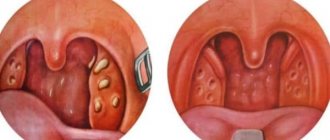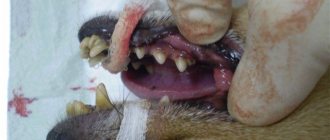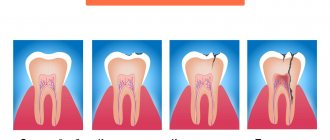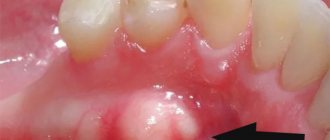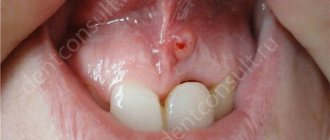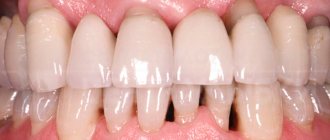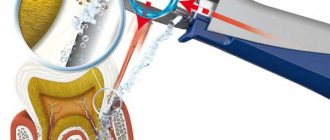Prices
Before after
Question answer
Price
Work examples
Question answer
Odontogenic periostitis, or simply flux, is a dangerous purulent disease in which inflammation affects the periosteum. The process is accompanied by painful sensations and swelling of the cheeks, so the only correct solution is to visit the dentist. Experienced doctors at the Smile Estet clinic will diagnose the problem and provide treatment to avoid tooth extraction.
Symptoms
Inflammation never goes unnoticed:
- a lot of pus forms at the site of infection;
- mucous membranes swell;
- persistent acute pain occurs.
IMPORTANT! Patients who like to be treated at home should know that flux treatment is only possible in a dental setting, since deep cleaning of infected tissues is necessary.
This disease does not go away on its own. By delaying your trip to the doctor, you only aggravate the situation, risk complications and can seriously ruin your life for a couple of weeks. In addition, swelling of the cheek is far from aesthetically pleasing.
Benefits of dental treatment at Smile Estet dentistry
Our dentists will make your stay in the dental chair comfortable
- Highly qualified specialists
- Modern equipment
- Family discount system
- Installment plan for dental treatment
Antibiotics for flux
As noted above, flux is a consequence of a bacterial infection, which is often treated by taking antibiotics. Many, at their own peril and risk, try to cope with inflammation by independently taking quite strong medications that can cause serious damage to the health of the entire body. Effective and at the same time safe treatment of flux with antibiotics can only be prescribed by a qualified specialist.
Antibiotics for flux are prescribed by a doctor individually. Self-use of strong medications is fraught with serious consequences for the entire body.
Antibiotics, like anti-inflammatory drugs, are used in dentistry for flux as part of complex maintenance therapy. The only way to stop the inflammatory process and remove the pus is surgery. Antibiotics are usually prescribed at the very beginning of treatment if the disease is in the earliest stages of its development, but identifying such inflammation at the initial stage can be quite difficult. As a rule, the dentist is able to detect the very first signs of periostitis by accident, for example, during a routine examination of the oral cavity. The specialist prescribes antibiotics for flux individually, depending on the characteristics of the patient’s body and the general clinical picture.
What types of flux do we treat?
Acute serous
The disease may develop over 2-3 days and then go away. But the absence of pain is deceptive - pus remains in the tissues and needs to be cleaned out.
Purulent
The mucous membranes swell significantly due to the accumulation of purulent masses, which affects the symmetry of the face.
Diffuse
Accompanied by intoxication of the body, increased body temperature, and weakness.
Chronic
In the lower jaw, a purulent accumulation with slight swelling can become a permanent phenomenon. There is nowhere for the pus to escape, so the illness can last for months or even years.
Treatment of gumboil in dentistry
If you suddenly notice that your cheek is suspiciously swollen, and even if there is no pain, you should immediately contact a dentist without waiting for the abscess to develop to its full potential. The doctor will determine the cause of the flux and prescribe the required treatment.
In the early stages, when the abscess is still maturing, it is possible to save the tooth. To do this, it is necessary to ensure the outflow of necrotic masses. The doctor uses local anesthesia to cut the gum to gain access to the periosteum. Then he rinses the cavity with antiseptics and installs drainage. In some cases, the affected hard tissue is drilled and the root canals are cleaned.
If you manage to get the pus out, the acute symptoms immediately subside. The patient feels relief within 12 hours. Only slight swelling remains, which goes away after about 3 days. Until this point, the drainage tube remains in the gum.
In complex cases of periostitis, if the crown is destroyed by more than 50% and cannot be restored, tooth extraction cannot be avoided. Also, an indication for the procedure is relapse of flux. If drainage was previously carried out, but it did not produce results, or suppuration has resumed, the tooth will not be saved. Most often, dentists offer painless tooth extraction.
Physiotherapeutic procedures are additionally prescribed for treatment. This is exposure to current, ultrasound, electromagnetic field or laser. The manipulations are aimed at relieving inflammation. For best results, 5-7 sessions are required. The general treatment period for periostitis is about a week from the moment you seek medical help.
Don't wait until the pain becomes unbearable. You still have to go, so it’s better to do it earlier. And, of course, there is no need to be afraid. All manipulations are performed under local anesthesia. Your job is to come to the clinic.
Work examples
All works
Ruslan Davudovich
Dental surgeon, implantologist
Vladimir Kimovich
Orthopedic dentist, implantologist, maxillofacial surgeon
How is flux removed?
Conservative therapy
If you contact your dentist at the first sign of a problem, you can avoid surgery. The cost of flux treatment in this case will be minimal. The doctor will eliminate the foci of carious infection. Most often, bacteria penetrate into the root canals, so they are cleaned and subsequently sealed. Therapy includes taking anti-inflammatory drugs, and in some cases antibiotics. Laser cleaning of gum pockets is also effective.
Surgery
In difficult cases, it complements conservative therapy. If there is a significant accumulation of purulence (most often in the lower jaw), the swollen gum will have to be opened. To do this, the surgeon makes a small incision, washes out the purulent contents, carries out antiseptic treatment, and installs drainage so that new pus does not accumulate in the tissues. The patient is prescribed an anti-inflammatory rinse and antibiotic therapy.
Diagnostics
Before proceeding with dental flux treatment, the doctor must conduct an appropriate diagnostic examination. The exact diagnosis is determined based on data obtained during a clinical examination and x-ray diagnosis. Laboratory tests allow you to accurately determine the stage of the inflammatory process. Only after making an accurate diagnosis will a specialist be able to decide what to do with gumboil and which method of treatment in this particular case will be optimal.
How much does it cost to cure gumboil?
As we have already noted, costs depend entirely on the complexity of the clinical case. In advanced situations, the cost of flux treatment will include complex tooth-saving surgery. Therefore, contact your dentist on time - Smile Estet will help you solve the problem.
| Service | Price |
| Consultation | |
| Appointment and examination by a dentist-therapist | RUR 3,000 Free R Promotion until November 30 |
| Appointment with a dental surgeon | RUR 3,000 Free R Promotion until November 30 |
| Appointment with an orthopedic dentist | 2,000 RUR Free R Promotion until November 30 |
| Appointment with an orthodontist | 2,000 RUR Free R Promotion until November 30 |
| Surgical treatment and operations | |
| Removal of a tooth with a high degree of mobility | up to 4,500 R |
| Removal is simple | RUR 4,500 RUR 3,000 Promotion until November 30 |
| Removal is difficult | 8,000 R 7,000 R Promotion until November 30 |
| Autologous bone collection | 16,000 R |
| Gingivoplasty | 8,000 R |
| Plasmolifting | RUR 3,000 |
| Closed sinus lift in the area of one implant | 10,000 R |
| Open sinus lift in the area of one implant (excluding material cost) | RUB 30,000 |
| Bone grafting using the NDT method in the area of the 1st implant (excluding the cost of the material) | RUB 8,500 |
| Bone plastic material Bio-Oss | 12,000 R |
| Bio-Gide Collagen Membrane | 13,000 R |
| Membrane and gel “Plasmolifting” (1 piece) | RUR 3,000 |
| Resection of the root apex of one tooth | 8,000 R |
| Removal of the tooth nerve (treatment of pulpitis of 1 canal tooth with laser) | RUR 25,000 |
Stock
All promotions
for 3 000 0
Free consultation with any specialist + photo as a gift until November 30
for 25,000 15,000
Profitable whitening for 15,000 ₽. Special price valid until November 30
for 6,000 5,000
Complete professional hygiene for 5,000 ₽. The promotion is valid until November 30
for 140,000 120,000
Installation of 4 ceramic composite veneers in the smile area for RUB 120,000! Promotion until November 30
for 21,000 17,000
Ceramic crown per tooth for 17,000 ₽. Saving 4,000 ₽! Promotion until November 30
for 16,500 12,500
Tooth restoration with metal ceramics. Promotion until November 30
for 32,000 28,000
Restoration of one tooth with a zirconium dioxide crown for 28,000 ₽. Promotion until November 30
for 400,000 370,000
Restoration of one jaw in a 72-hour protocol. Promotion until November 30
for 200,000 150,000
Complex restoration of one jaw All-on-4. Promotion until November 30
for 540,000 500,000
For acute bone tissue atrophy and periodontal disease on 8-10 Oneway Biomed implants (Switzerland). Promotion until November 30
for 0
Turnkey tooth implantation for 50,000 ₽! Promotion until November 30
for 250,000 200,000
Complex restoration of one jaw All-on-6. Promotion until November 30
for 3 000 0
Free consultation with any specialist + photo as a gift until November 30
for 25,000 15,000
Profitable whitening for 15,000 ₽. Special price valid until November 30
for 6,000 5,000
Complete professional hygiene for 5,000 ₽. The promotion is valid until November 30
for 140,000 120,000
Installation of 4 ceramic composite veneers in the smile area for RUB 120,000! Promotion until November 30
for 21,000 17,000
Ceramic crown per tooth for 17,000 ₽. Saving 4,000 ₽! Promotion until November 30
for 16,500 12,500
Tooth restoration with metal ceramics. Promotion until November 30
for 32,000 28,000
Restoration of one tooth with a zirconium dioxide crown for 28,000 ₽. Promotion until November 30
for 400,000 370,000
Restoration of one jaw in a 72-hour protocol. Promotion until November 30
for 200,000 150,000
Complex restoration of one jaw All-on-4. Promotion until November 30
for 540,000 500,000
For acute bone tissue atrophy and periodontal disease on 8-10 Oneway Biomed implants (Switzerland). Promotion until November 30
for 0
Turnkey tooth implantation for 50,000 ₽! Promotion until November 30
for 250,000 200,000
Complex restoration of one jaw All-on-6. Promotion until November 30
Causes of pathology
Most often, people who neglect preventive examinations at the dentist have to deal with gumboil. After all, one of the main reasons for the appearance of gumboil is advanced caries. It makes the tooth defenseless against pathogenic bacteria. Through the canals they penetrate into the root of the tooth, and then spread into the periosteum and bone tissue. This causes an inflammatory process and the formation of a purulent focus.
In addition, the occurrence of periostitis may be preceded by:
- chronic infectious ENT diseases (tonsillitis, sinusitis);
- mechanical trauma to the jaw;
- pathological deposits on teeth - hard and soft plaque, tartar;
- untreated dental diseases;
- inflammation of the periodontal pocket.
Flux can also be a consequence of a root cyst of the tooth. It is a neoplasm in the form of a purulent sac between the root of the tooth and the jaw bone.
Most of these factors are closely related. For example, insufficient oral hygiene provokes the appearance of putrefactive microflora in the oral cavity. This serves as a favorable environment for the development of infection, which is the cause of various kinds of pathological processes.
